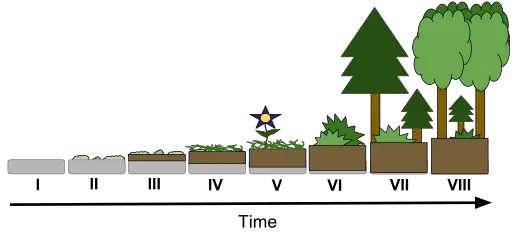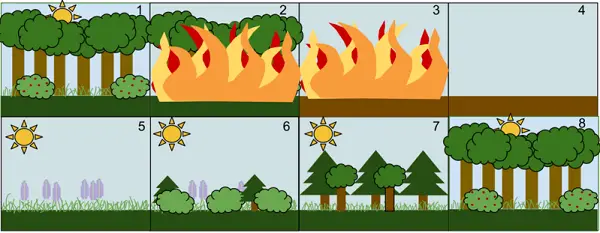Ecological Succession
When the field of ecology was young, it was viewed that communities are more or less stable in structure and species composition. But as we know, some communities experience disturbances such as storms, fires, floods, or human activities that change the community by removing organisms or altering the availability of resources. Disturbances vary in frequency and severity in different communities.
Although we might think of disturbances as negative, small-scale disturbances often have positive effects. Think of a tree in a forest being uprooted, it will open space for small seedlings or allow light to reach the forest floor in that area.
Severe disturbances, however, could alter communities drastically which may lead to different species colonizing the disturbed area and would again alter the community structure. The gradual replacement by a series of other species is the process known as ecological succession.
Primary Succession
Ecological succession begins in a virtually lifeless area, without soil, and is called primary succession. Examples would be areas left by a recent volcanic lava flow. Often, autotrophic bacteria are initially present. Lichens and moss which are blown as spores are the larger photosynthetic organisms that would grow there next.

Soil develops gradually as rocks break down and organic matter accumulates from the decomposed remains of the early colonizers. These would then be overgrown by larger plants that would sprout from seeds carried from nearby areas or introduced by animals into the area. Eventually, the area is colonized by larger plants that become the community’s most common form of vegetation.
Secondary succession
Secondary succession occurs when a disturbance takes place and clears the existing community but leaves the soil intact. For example, we mentioned how chaparrals have periodic fires. Areas that are recovering from these types of disturbances show secondary succession.

Some disturbances that lead to secondary succession are caused by human activities and understanding the effects of disturbance in communities is especially important in the present because people are more widespread and can become significant agents of disturbances.
A community is situated in an ecosystem. In the next topic, we will take a look at an ecosystem’s structure and the interactions that comprise it.
Next topic: Ecosystem Structure and Dynamics
Previous topic: Community Structure and Dynamics
Return to the main article: The Principles of Ecology
Download Article in PDF Format.
Test Yourself!
1. Practice Questions [PDF Download]
2. Answer Key [PDF Download]
Copyright Notice
All materials contained on this site are protected by the Republic of the Philippines copyright law and may not be reproduced, distributed, transmitted, displayed, published, or broadcast without the prior written permission of filipiknow.net or in the case of third party materials, the owner of that content. You may not alter or remove any trademark, copyright, or other notice from copies of the content. Be warned that we have already reported and helped terminate several websites and YouTube channels for blatantly stealing our content. If you wish to use filipiknow.net content for commercial purposes, such as for content syndication, etc., please contact us at legal(at)filipiknow(dot)net
